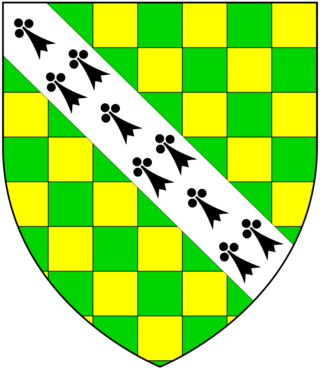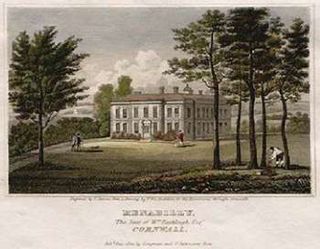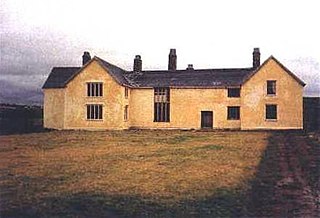
Tywardreath is a small hilltop village on the south coast of Cornwall, England, United Kingdom, about 3 miles (5 km) north west of Fowey. It is located in a sheltered spot overlooking a silted up estuary opposite Par and near the beach of Par Sands. It is on the Saints' Way path.

Philip Rashleigh of Menabilly, Cornwall, was an antiquary and Fellow of the Royal Society and a Cornish squire. He collected and published the Trewhiddle Hoard of Anglo-Saxon treasure, which still gives its name to the "Trewhiddle style" of 9th century decoration.

Gribbin Head is a promontory on the south coast of Cornwall, England, UK, owned and managed by the National Trust. It separates St Austell Bay from the estuary of the River Fowey and is marked by a large tower used to aid navigation of ships approaching the local harbours. The nearest town is Fowey. The western point of the headland is called Little Gribbin.

Jonathan I Rashleigh, of Menabilly, near Fowey in Cornwall, was an English shipping-merchant, Member of Parliament for Fowey in 1614, 1621, 1625, April 1640 and November 1640, and 1661 and served as Sheriff of Cornwall in 1627. He supported the Royalist cause during the Civil War.

John Rashleigh II of Menabilly, near Fowey in Cornwall, was an English merchant and was MP for Fowey in 1588 and 1597, and was High Sheriff of Cornwall in 1608. He was the builder of the first mansion house on the family estate at Menabilly, near Fowey, Cornwall, thenceforth the seat of the family until the present day. Many generations later the Rashleigh family of Menabilly in the Return of Owners of Land, 1873 was listed as the largest landowner in Cornwall with an estate of 30,156 acres (122.04 km2) or 3.97% of the total area of Cornwall.

John Rashleigh of Coombe, near Fowey in Cornwall, was MP for Fowey from 1661 to 1679. He was a member of a branch of the more prominent Rashleigh family of Menabilly, near Fowey.

Sir John Carew, 3rd Baronet of Antony, Cornwall, was an English politician who sat in the House of Commons variously between 1660 and 1692.

John Sparke of The Friary, in the parish of St Jude, Plymouth, Devon, was an English politician who sat in the House of Commons from 1628 to 1629.
Jonathan Rashleigh was an English landowner, local politician, and collector and numismatist of some repute.

Philip Rashleigh (1689–1736) of Menabilly, near Fowey, Cornwall, was a British landowner and politician who sat in the House of Commons from 1710 to 1722.

Jonathan Rashleigh (1642–1702) of Menabilly, near Fowey, Cornwall was Sheriff of Cornwall in 1686/87, and twice MP for Fowey 1675–1681 and 1689–1695. His portrait exists at Antony House, Torpoint, Cornwall, formerly the home of his second wife Sarah Carew.
Jonathan Rashleigh of Menabilly, Cornwall, was a British landowner and Tory politician who sat in the House of Commons for 37 years from 1727 to 1764.

William Rashleigh was an English politician and landowner from Cornwall.

Rashleigh is an historic former manor in the parish of Wembworthy, Devon. Rashleigh Barton, the former manor house, is a grade II* listed building, situated 5 miles north-east of the village of Wembworthy. It was the earliest known seat of the ancient Rashleigh family, a junior branch of which is still seated at Menabilly in Cornwall, and in the 16th century, on the failure of the male line, passed from the senior line of the Rashleigh family via a sole heiress to the Clotworthy family of Clotworthy in the same parish of Wembworthy.

Wembworthy is a small village, parish and former manor in Mid-Devon, England. It is situated in the valley of the River Taw, 8 miles north-east of the towns of Hatherleigh and 12 miles south of South Molton. St Michael's Church is the parish church, much rebuilt in the 1840s. The vestigial remnants of two mediaeval earthwork castles survive within the parish, one in Heywood Wood, of motte and bailey form, the other to its south of ringwork and bailey form.
Sir John Colman Rashleigh, 1st Baronet was the first of the Rashleigh baronets and known as a leading figure among the gentry in the parliamentary reform movement.

Sir Robert Basset (1573–1641), lord of the manor of Umberleigh and lord of the manor of Heanton Punchardon in Devon, England, was MP for Plymouth in 1593.
Trethurffe is an historic estate in the parish of Ladock, near Truro, in Cornwall.

Tregaminion Church is a Church of England church in Tregaminion, Cornwall, England, UK. The church dates to the early 19th century and is a Grade II* listed building.














